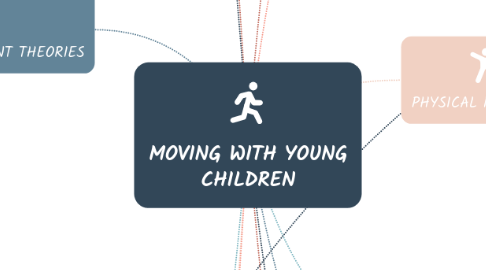
1. IMPLEMENTATION IN CENTRES
1.1. TYPES OF PLAY
1.1.1. STRUCTURED PLAY
1.1.2. UNSTRUCTURED PLAY
1.2. EQUIPMENT
2. MEANING MAKING AND MOVEMENT
2.1. SENSE OF SELF
2.2. PUBLIC PLACES
2.3. CONNECTION TO PLACE THROUGH MOVEMENT
3. STAGE DEVELOPMENT THEORIES
3.1. 0-4 MONTHS
3.1.1. - Moves whole body - Squirms, arms wave, legs move up and down - Responds to gentle touching, cuddling and rocking - Able to lift head and chest when laying on stomach - Begins to roll from side to side - Starts reaching to swipe at dangling objects - Able to grasp object put into hands
3.2. 4-8 MONTHS
3.2.1. - Plays with feet and toes - Makes crawling movements when lying on stomach - Rolls from back to stomach - Reaches for and grasp objects, using one hand to grasp - Crawling movements using both hands and feet
3.3. 8-12 MONTHS
3.3.1. - Raises self to sitting position - Sits without support - Stands by pulling themselves up using furniture - Successfully reach out and grasp toy - Picks up and throws small objects - Mature crawling - Uses hand to feed self
3.4. 1-2 YEARS
3.4.1. - Walks, climbs and runs - Legs wide and hands up for balance with small steps - Dances in place to music - Kicks and throws a ball - Squat to pick up an object - Can drink from a cup
3.5. 2-3 YEARS
3.5.1. - Walks, runs, climbs, kicks and jumps easily - Uses one step at a time - Catches ball rolled to them - Walks into a ball to kick it - Attempts to balance on one foot - Avoids obstacles
3.6. 3-5 YEARS
3.6.1. - Hops, jumps and runs with ease - Climbs steps with alternating feet - Gallops and skips by leading with one foot - Attempts to catch a ball with hands - Climbs playground equipment - Independently cuts paper with scissors - Walks and runs more smoothly
4. Relationships with the people we love are nurtured through our physical experiences with them.
5. BENEFITS OF MOVEMENT
5.1. INTELLECTUAL
5.1.1. Physical activities stimulate the cnnection between the mind and body. Children learn problem-solving skills as they try different actions.
5.2. SOCIAL
5.3. PHYSICAL
5.3.1. Using their bodies to explore and communicate provides the exercise babies and toddlers need to grow strong and healthy bodies.
5.4. LANGUAGE
5.4.1. Movement is an essential means fo communication and is on eod the earliest ways in which children express their thoughts and feelings.
6. ACTIVE PLAY
6.1. IN PHYSICAL ENVIRONMENTS
6.2. CHILD-INITIATED PLAY
7. Intentional Teaching
8. ENVIRONMENT
8.1. INDOOR PLAY
8.1.1. Spontaneous
8.1.1.1. A form of creative play which gives childrent the freedom of choice.
8.1.2. Intentional
8.1.2.1. Planned play which may have set times, rules and special equipment.
8.1.3. Active Transport
8.1.3.1. Using physical activity to travel.
8.2. SITUATED, LOCAL & PLACE-BASED
8.3. OUTDOOR PLAY
8.3.1. Balance Skills
8.3.2. RISK-INITIATED PLAY
9. PHYSICAL MOVEMENT
9.1. Laterality
9.1.1. Children must develop an understanding that the body is composed of two sides.
9.2. Directionality
9.2.1. Helps children to understand the space around them and the relationship of things in that space.
9.3. Crossing the Midline
9.3.1. A child's body part crosses over spontaneously to the other sude of the body to complete a task, improving coordination and fine motor skills.
9.4. LABAN MOVEMENTS
10. CURRICULUM FRAMEWORKS
10.1. VICTORIAN EARLY YEARS AND DEVELOPMENT FRAMEWORK
10.2. NATIONAL QUALITY STANDARDS
11. EDUCATOR ROLE
11.1. Safety
11.2. Physical Active Policies
12. Fundamental Movement Skills
12.1. Locomotor Skills
12.1.1. crawling, walking, running, jumping, galloping and hopping.
12.2. Stability Skills
12.2.1. stretching, bending, twisting and balancing.
